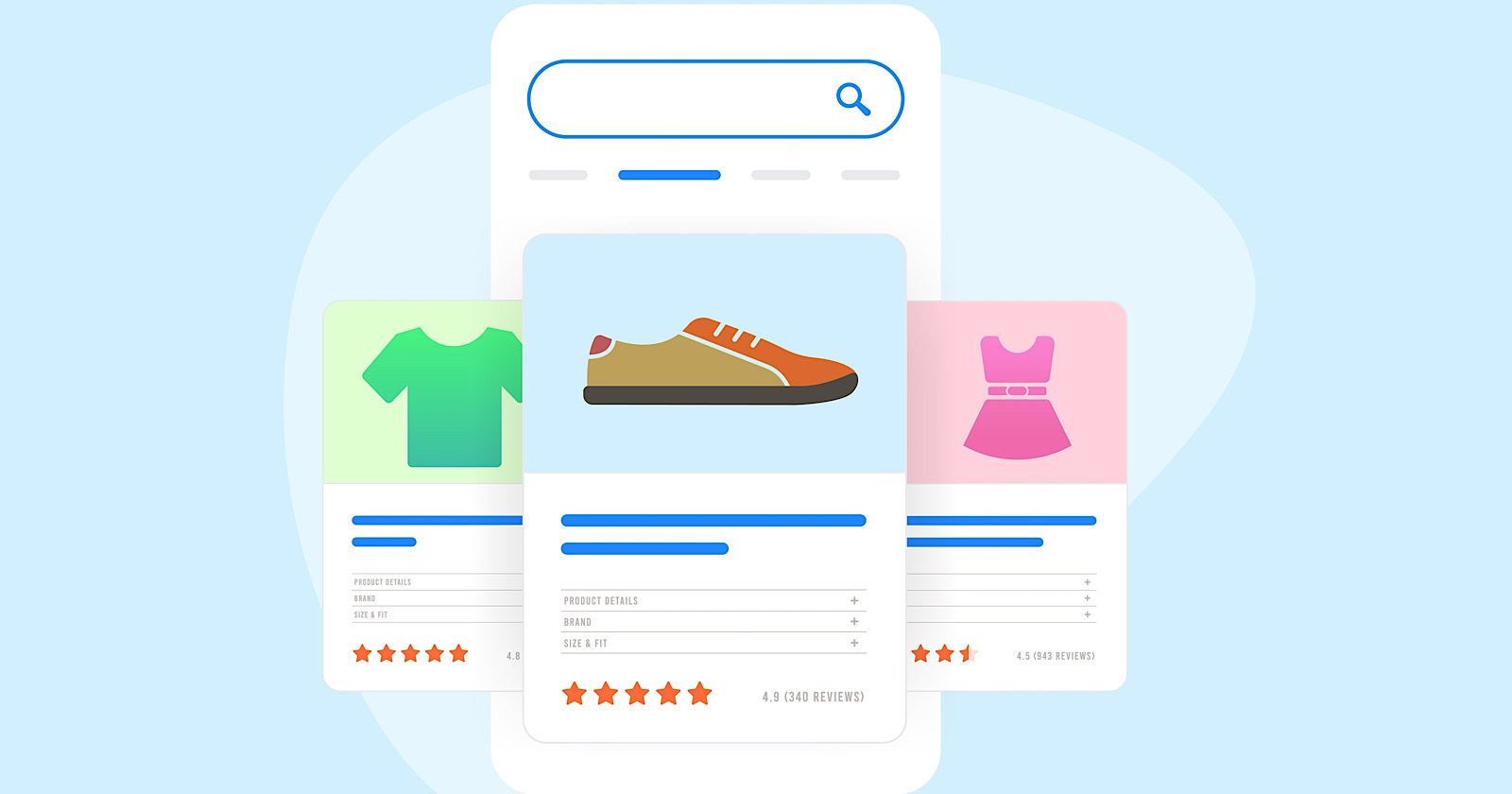SEO
Drive Online Sales With These 5 Search Optimizations

Remember when you had to leave the house to go shopping? What a hassle that was.
But then, way back in 1982, Boston Computer Exchange was launched as the first ecommerce site and the convenience of shopping in your underwear was born.
Today, electronic commerce, the buying, and selling of products and services on the internet is a massive part of the global economy.
In 2021, more than 2.14 billion people worldwide bought something online. And in the U.S., ecommerce sales for just the first quarter of 2022 totaled $250 billion.
We’ve come a long way from those early days of local used computer sales.
These days, you can find everything from shoes to mechanic services to $5,000 heart-shaped potatoes for sale with just a few clicks of the mouse. And nearly every business of every type has a website through which they’re selling their goods and services.
And while that’s really good for shoppers, if you’re an ecommerce retailer, that means you’re facing a lot of competition.
How do you stand out? How can you not only get people on your product pages but turn them into customers? It’s no small task.
But you’re in the right place.
In this article, you’ll find five essential ways you should optimize your ecommerce website for maximum exposure and ROI. Ready to get started? Scroll on.
1. Your Homepage Is Where The Heart Is
Your most-trafficked page, it’s often the first thing any visitor to your website will come across.
It sets the tone for your business, starts the conversion funnel, highlights sales or new products, and directs people to other parts of your site.
Of course, we’re talking about your homepage. And the first step to optimizing your ecommerce site to maximize sales is to make sure your homepage is living up to its weighty role.
Make Navigation Easy
One major issue you’ll want to tackle immediately when optimizing your homepage is navigation.
You want to make it easy and efficient for visitors (and search engine crawlers) to find your content. There should be clear direction as to where the content they want lives.
And a key part of that is using a prominent navigation bar.
In addition to helping users quickly navigate between parts of your site, the navigation bar is also a great opportunity to highlight specific parts of your website, for example, your best-selling product line.
Your homepage also should have an effective and prominent tagline.
Your tagline is a short, usually eight- to 12-word phrase that connects your company with its audience.
Sometimes mistakenly called a slogan (slogans are campaign-specific, taglines are brand-specific), taglines are something too many ecommerce retailers overlook – which is a mistake.
Many first-time visitors to your website will only give it a quick scan.
A descriptive and memorable tagline will help them quickly understand what your site is about and compel them to dive deeper. This leads us to our next point:
Content Is Still King
At the end of the day, content is still the single most important factor of your homepage or any page for that matter.
People are using the internet to find a particular product or solution.
If you offer what they need, you can convert them into sales – provided they land on your page and not your competition’s.
That starts with search engine optimization (SEO). And SEO starts with keywords.
Identify which words and phrases your target audience is looking for and include them organically in your copy. (That is, don’t force them where they don’t belong. This is called keyword stuffing and it can negatively impact your Google ranking.)
Have trouble identifying which keywords are most important? Search Engine Journal has a webinar that will help you determine and implement a keyword research strategy.
There are also a number of free tools you can use to help you decide what language needs to be included on your homepage.
Once you have your keyword strategy down, you can sit back and relax and watch the sales come rolling in, right? Of course not. You’re just getting started.
Next, you should think about the visual assets on your homepage.
Are you using generic stock photos to add visual interest or are you using this valuable web real estate to promote products? Smart ecommerce website operators will choose the latter.
You don’t need to include images of every single product you offer (and in fact, that’s probably a terrible idea), but using prominent images of your best-sellers on your homepage is very important. And make sure clicking on these images directs users to that product’s page.
Don’t underestimate the importance of using internal links. Create links to your most important pages directly from your homepage.
This could be a product category page or a link to your best-selling item. They could be in the navigation bar, the page’s footer, the content, or some combination of the three.
Another best practice is to make sure you’ve created a breadcrumb trail users (and search engine bots) can use to find their way back to the homepage.
For some examples of what a great homepage looks like, click here.
2. It’s All About The Products
The purpose of your ecommerce site is to make sales.
To achieve this, your product pages need to compel visitors to make purchases. Your product pages give you the perfect opportunity to control the narrative around each item you’re selling, which can make a big difference.
Here are some tips to make your product pages exceptional.
What’s In A Name?
Words can be very powerful. Your goal is to use that power to influence buying decisions. And that starts with your product titles.
It sounds deceptively easy, but it takes practice and A/B testing to get right.
Exactly what works for you will vary based on your industry, product, and audience, but here are some general guidelines:
- Use the right language. This doesn’t mean companies selling in Portugal should make sure all their product descriptions are all in Portuguese (though that is important), but rather that you’re using the same type of tone, words, and expressions your targets are. Write so the audience can understand you. And don’t forget your keywords!
- Use the right format. This will probably take some trial and error but is worth the effort. Find the length and the format that resonates the best with your potential customers. For example, you may find your perfect format is brand + size + color. Other factors you may include based on performance and product include product line, color, flavor, model number, and package size/quantity.
- Make your description complementary. Every product title should have a corresponding and complementary product description. Using search keywords, write an interesting description that avoids generic platitudes. For best results, remember the old copywriting adage: “Sell the sizzle, not the steak.” That means your descriptions should focus on the benefit to the customer, not the features of the product.
Get Meta
The meta description is the small blurb of copy that shows up under a link to your website in search engine results.
This is often your first opportunity to attract a customer.
The better your meta description, the more likely a searcher will click through to your site. And that dramatically increases your chances to make a sale.
Use keywords in your brand’s unique voice to create effective meta descriptions.
Make sure you’re specifically targeting the product’s targets with each page’s meta description, rather than using a general blurb about your company.
For more tips on creating the type of meta descriptions that generate traffic, click here.
Show Them What You’ve Got
Product images are vital because they show shoppers exactly what they’re in the market for.
The first thing visitors to your product pages will notice, they draw attention and trigger emotions in viewers. They also help them subconsciously envision the impact they will have on their lives.
Show them different aspects of the product, including different angles or “action shots” of it in use.
A video is also a useful tool, though not everyone will want to watch even short clips, so use them as complementary features.
Images are also a factor in your SEO ranking – and can both help and hurt you.
To ensure you’re getting the most from the visuals on your product pages, you should optimize your images for faster loading.
Not sure how to do that? Don’t worry, we’ve got just the thing. Click here for six tips for optimizing images for your ecommerce site.
Make Sure The Price Is Right
While bells and whistles that differentiate your product from the competition are nice and can play a role in purchasing decisions, many times, what determines if you get the sale is one thing: pricing.
But it’s not always about having the lowest price.
In fact, charging too little for your products can hurt the perception of your brand, as customers will assume they’re getting what they paid for, that is, cheap junk.
Try to find that sweet spot where you make the highest profit from the most sales.
And to help customers overcome analysis paralysis, give them side-by-side pricing comparisons.
This helps facilitate decision-making by allowing visitors to compare their options in one place. And nothing makes a price seem lower than showing it right next to a premium option that significantly costs more.
Another trick, which you’ve undoubtedly already aware of is so-called “charm pricing,” or ending prices with $.99.
The rational part of the customer’s brain knows there’s no real difference between a product that costs $299.99 and another that costs $300, but studies have shown most people judge prices by the leftmost digit. Use this psychological trick to your advantage.
Don’t Take Our Word For It
There’s a reason Amazon features reviews so highly on its product pages – they work.
Consumers trust and rely upon the opinions of people who have already bought your offering.
But, did you know customers who interact with reviews are 58% more likely to convert? That alone should be enough to convince you to add them to your product pages.
Other Tips
Another thing you don’t want to neglect on your product page is calls to action (CTAs).
The first thing most salespeople are taught is if you want the sale, you must ask for it.
Make sure you’re providing clear CTAs on your product pages, for example, a large button that reads “Buy Now.”
And if you sell out of a particular item, do NOT deactivate the link.
By keeping it live, you avoid it being identified as a broken link and dinging your SEO score. Simply indicate that this product is currently out of stock.
3. Don’t Ignore Usability
If you want to make sales, your ecommerce site must be user-friendly.
Without well-designed UX/UI (that is, user experience and user interaction), people will navigate away before you can pitch your product, let alone make a sale.
Minimize your bounce rate by ensuring your homepage avoids common UX pitfalls.
Solve Your Technical Issues
Before you do anything else, you need to make sure your website loads quickly for every user.
Within three seconds, and ideally less, your homepage should display its content to visitors.
If not, users, especially mobile users, are likely to become frustrated and look for another digital merchant.
For more information on how to evaluate and speed up your loading time, this article can help.
And speaking of mobile users, your site absolutely must be responsive.
Phones accounted for 54.4% of global web traffic last year and that number keeps growing. If your homepage isn’t responsive, you’re losing potential customers.
Consider How Your Site Is Being Used
While not everyone will use your website the same way, there should be a general path most users follow.
Identify this and make sure the steps are clear. And remember, from time to time, people will get lost. Make it easy for them to find what they’re looking for by including a search bar.
Don’t forget to tell your company’s story.
The “About Us” page is more than a chance to brag about how great you are, it’s also a chance to share your history, your values, and your services.
For more tips on creating a top-notch About Us page, check out these examples.
And sometimes, your customers will need to speak to a real person, whether over the phone or via email.
Make sure you have a contact page that doesn’t require a lot of searching to find. Make sure your phone number and email address are listed, so you can be reached with questions, concerns, exchanges, and the like.
4. Blog Your Way To Sales
Does your ecommerce site have a blog? It should.
And no, that short-lived personal blog about inconsistencies in the Star Wars universe you ran 10 years ago isn’t going to cut it. You need a dedicated business blog discussing topics relevant to your products and customers.
There are several reasons blogging is important, not least of all from an SEO point of view.
Creating new posts means you’re creating new content, which signals to search engines your site is active. It’s also a means to generate those all-important backlinks.
A quality blog also helps establish your reputation as an authority in your niche, contributes to your brand image, and even decreases bounce rate.
Make your blog an asset to your ecommerce site by creating and implementing a good content strategy built on three key factors: people, technology, and process.
And remember, your blog is your chance to show off your personality. Because it’s a more informal conversation with customers than other, more rigid marketing materials, you can have more fun.
Create the kind of posts that show you’re passionate about your products and happy to share your expertise.
And don’t forget the social media share buttons (which are also an excellent idea for product pages). This allows people to spread your posts outside of your normal audience, generating more exposure and ideally leading to more sales.
Looking for inspiration? Here are nine ecommerce companies doing blogging the right way.
5. Build A Solid Structure
We’ve touched on different aspects of your ecommerce site’s structure so far, but it’s so important it deserves its own section.
One rule you should live by is that all your content should be accessible to visitors within three clicks from your homepage.
Any more than that, and you run a very real risk of customers abandoning the journey.
On that note, your purchasing process should be as streamlined as possible.
Use the minimum number of pages possible to complete a transaction and keep your checkout page simple and straightforward.
Make sure it is always clear to customers where they are in the checkout process.
Have you ever noticed how many e-retailers use the shopping cart icon in the top right corner of their pages? That’s because it works. Don’t try to reinvent the wheel.
Make sure your URL structure is logical and easy to follow.
For example, a product web address of www.example.com/manufacturer/category/item will get more clicks from search engine results pages than www.example.com/01178/iadtttkyu.
Build your entire site around a solid, easy-to-find, easy-to-navigate sitemap, and make sure it’s optimized to be indexed by search engine crawlers, so your pages show up in search engine results.
Finally, because you’re dealing with financial transactions, make sure you’re using adequate security measures.
Make sure your ecommerce site is hosted on a secure platform and consider adding two-factor authentication to prevent purchases made with stolen user credentials.
You should only collect and store the personal data you need.
The Bottom Line
Unfortunately, there is no one magic bullet that will work for every ecommerce business.
What works for an organic dried mushroom merchant is not guaranteed to work for a video game reseller. And what works for the video game store may not work for a beauty brand. It’s up to you to find what works.
However, armed with the knowledge you’ve gained in this article, you should be prepared to begin taking steps to optimize your own ecommerce site.
Above all, remember what your site is trying to accomplish: selling specific products to specific targets.
If you can keep potential customers in mind, while tweaking some technical things to boost your search engine results and smooth out the customer journey, you’re doing all you can to set your business on the path to success.
Happy selling!
Featured Image: fizkes/Shuttertock
SEO
Google Cautions On Blocking GoogleOther Bot

Google’s Gary Illyes answered a question about the non-search features that the GoogleOther crawler supports, then added a caution about the consequences of blocking GoogleOther.
What Is GoogleOther?
GoogleOther is a generic crawler created by Google for the various purposes that fall outside of those of bots that specialize for Search, Ads, Video, Images, News, Desktop and Mobile. It can be used by internal teams at Google for research and development in relation to various products.
The official description of GoogleOther is:
“GoogleOther is the generic crawler that may be used by various product teams for fetching publicly accessible content from sites. For example, it may be used for one-off crawls for internal research and development.”
Something that may be surprising is that there are actually three kinds of GoogleOther crawlers.
Three Kinds Of GoogleOther Crawlers
- GoogleOther
Generic crawler for public URLs - GoogleOther-Image
Optimized to crawl public image URLs - GoogleOther-Video
Optimized to crawl public video URLs
All three GoogleOther crawlers can be used for research and development purposes. That’s just one purpose that Google publicly acknowledges that all three versions of GoogleOther could be used for.
What Non-Search Features Does GoogleOther Support?
Google doesn’t say what specific non-search features GoogleOther supports, probably because it doesn’t really “support” a specific feature. It exists for research and development crawling which could be in support of a new product or an improvement in a current product, it’s a highly open and generic purpose.
This is the question asked that Gary narrated:
“What non-search features does GoogleOther crawling support?”
Gary Illyes answered:
“This is a very topical question, and I think it is a very good question. Besides what’s in the public I don’t have more to share.
GoogleOther is the generic crawler that may be used by various product teams for fetching publicly accessible content from sites. For example, it may be used for one-off crawls for internal research and development.
Historically Googlebot was used for this, but that kind of makes things murky and less transparent, so we launched GoogleOther so you have better controls over what your site is crawled for.
That said GoogleOther is not tied to a single product, so opting out of GoogleOther crawling might affect a wide range of things across the Google universe; alas, not Search, search is only Googlebot.”
It Might Affect A Wide Range Of Things
Gary is clear that blocking GoogleOther wouldn’t have an affect on Google Search because Googlebot is the crawler used for indexing content. So if blocking any of the three versions of GoogleOther is something a site owner wants to do, then it should be okay to do that without a negative effect on search rankings.
But Gary also cautioned about the outcome that blocking GoogleOther, saying that it would have an effect on other products and services across Google. He didn’t state which other products it could affect nor did he elaborate on the pros or cons of blocking GoogleOther.
Pros And Cons Of Blocking GoogleOther
Whether or not to block GoogleOther doesn’t necessarily have a straightforward answer. There are several considerations to whether doing that makes sense.
Pros
Inclusion in research for a future Google product that’s related to search (maps, shopping, images, a new feature in search) could be useful. It might be helpful to have a site included in that kind of research because it might be used for testing something good for a site and be one of the few sites chosen to test a feature that could increase earnings for a site.
Another consideration is that blocking GoogleOther to save on server resources is not necessarily a valid reason because GoogleOther doesn’t seem to crawl so often that it makes a noticeable impact.
If blocking Google from using site content for AI is a concern then blocking GoogleOther will have no impact on that at all. GoogleOther has nothing to do with crawling for Google Gemini apps or Vertex AI, including any future products that will be used for training associated language models. The bot for that specific use case is Google-Extended.
Cons
On the other hand it might not be helpful to allow GoogleOther if it’s being used to test something related to fighting spam and there’s something the site has to hide.
It’s possible that a site owner might not want to participate if GoogleOther comes crawling for market research or for training machine learning models (for internal purposes) that are unrelated to public-facing products like Gemini and Vertex.
Allowing GoogleOther to crawl a site for unknown purposes is like giving Google a blank check to use your site data in any way they see fit outside of training public-facing LLMs or purposes related to named bots like GoogleBot.
Takeaway
Should you block GoogleOther? It’s a coin toss. There are possible potential benefits but in general there isn’t enough information to make an informed decision.
Listen to the Google SEO Office Hours podcast at the 1:30 minute mark:
Featured Image by Shutterstock/Cast Of Thousands
SEO
AI Search Boosts User Satisfaction

A new study finds that despite concerns about AI in online services, users are more satisfied with search engines and social media platforms than before.
The American Customer Satisfaction Index (ACSI) conducted its annual survey of search and social media users, finding that satisfaction has either held steady or improved.
This comes at a time when major tech companies are heavily investing in AI to enhance their services.
Search Engine Satisfaction Holds Strong
Google, Bing, and other search engines have rapidly integrated AI features into their platforms over the past year. While critics have raised concerns about potential negative impacts, the ACSI study suggests users are responding positively.
Google maintains its position as the most satisfying search engine with an ACSI score of 81, up 1% from last year. Users particularly appreciate its AI-powered features.
Interestingly, Bing and Yahoo! have seen notable improvements in user satisfaction, notching 3% gains to reach scores of 77 and 76, respectively. These are their highest ACSI scores in over a decade, likely due to their AI enhancements launched in 2023.
The study hints at the potential of new AI-enabled search functionality to drive further improvements in the customer experience. Bing has seen its market share improve by small but notable margins, rising from 6.35% in the first quarter of 2023 to 7.87% in Q1 2024.
Customer Experience Improvements
The ACSI study shows improvements across nearly all benchmarks of the customer experience for search engines. Notable areas of improvement include:
- Ease of navigation
- Ease of using the site on different devices
- Loading speed performance and reliability
- Variety of services and information
- Freshness of content
These improvements suggest that AI enhancements positively impact various aspects of the search experience.
Social Media Sees Modest Gains
For the third year in a row, user satisfaction with social media platforms is on the rise, increasing 1% to an ACSI score of 74.
TikTok has emerged as the new industry leader among major sites, edging past YouTube with a score of 78. This underscores the platform’s effective use of AI-driven content recommendations.
Meta’s Facebook and Instagram have also seen significant improvements in user satisfaction, showing 3-point gains. While Facebook remains near the bottom of the industry at 69, Instagram’s score of 76 puts it within striking distance of the leaders.
Challenges Remain
Despite improvements, the study highlights ongoing privacy and advertising challenges for search engines and social media platforms. Privacy ratings for search engines remain relatively low but steady at 79, while social media platforms score even lower at 73.
Advertising experiences emerge as a key differentiator between higher- and lower-satisfaction brands, particularly in social media. New ACSI benchmarks reveal user concerns about advertising content’s trustworthiness and personal relevance.
Why This Matters For SEO Professionals
This study provides an independent perspective on how users are responding to the AI push in online services. For SEO professionals, these findings suggest that:
- AI-enhanced search features resonate with users, potentially changing search behavior and expectations.
- The improving satisfaction with alternative search engines like Bing may lead to a more diverse search landscape.
- The continued importance of factors like content freshness and site performance in user satisfaction aligns with long-standing SEO best practices.
As AI becomes more integrated into our online experiences, SEO strategies may need to adapt to changing user preferences.
Featured Image: kate3155/Shutterstock
SEO
Google To Upgrade All Retailers To New Merchant Center By September

Google has announced plans to transition all retailers to its updated Merchant Center platform by September.
This move will affect e-commerce businesses globally and comes ahead of the holiday shopping season.
The Merchant Center is a tool for online retailers to manage how their products appear across Google’s shopping services.
Key Changes & Features
The new Merchant Center includes several significant updates.
Product Studio
An AI-powered tool for content creation. Google reports that 80% of current users view it as improving efficiency.
This feature allows retailers to generate tailored product assets, animate still images, and modify existing product images to match brand aesthetics.
It also simplifies tasks like background removal and image resolution enhancement.
Centralized Analytics
A new tab consolidating various business insights, including pricing data and competitive analysis tools.
Retailers can access pricing recommendations, competitive visibility reports, and retail-specific search trends, enabling them to make data-driven decisions and capitalize on popular product categories.
Redesigned Navigation
Google claims the new interface is more intuitive and cites increased setup success rates for new merchants.
The platform now offers simplified website verification processes and can pre-populate product information during setup.
Initial User Response
According to Google, early adopters have shown increased engagement with the platform.
The company reports a 25% increase in omnichannel merchants adding product offers in the new system. However, these figures have yet to be independently verified.
Jeff Harrell, Google’s Senior Director of Merchant Shopping, states in an announcement:
“We’ve seen a significant increase in retention and engagement among existing online merchants who have moved to the new Merchant Center.”
Potential Challenges and Support
While Google emphasizes the upgrade’s benefits, some retailers, particularly those comfortable with the current version, may face challenges adapting to the new system.
The upgrade’s mandatory nature could raise concerns among users who prefer the existing interface or have integrated workflows based on the current system.
To address these concerns, Google has stated that it will provide resources and support to help with the transition. This includes tutorial videos, detailed documentation, and access to customer support teams for troubleshooting.
Industry Context
This update comes as e-commerce platforms evolve, with major players like Amazon and Shopify enhancing their seller tools. Google’s move is part of broader efforts to maintain competitiveness in the e-commerce services sector.
The upgrade could impact consumers by improving product listings and providing more accurate information across Google’s shopping services.
For the e-commerce industry as a whole, it signals a continued push towards AI-driven tools and data-centric decision-making.
Transition Timeline
Google states that retailers will be automatically upgraded by September if they still need to transition.
The company advises users to familiarize themselves with the new features before the busy holiday shopping period.
Featured Image: BestForBest/Shutterstock
-

 SEARCHENGINES6 days ago
SEARCHENGINES6 days agoBillions Of Google goo.gl URLs To 404 In The Future
-
SEARCHENGINES4 days ago
Daily Search Forum Recap: July 22, 2024
-

 SEARCHENGINES7 days ago
SEARCHENGINES7 days agoGoogle Core Update Coming, Ranking Volatility, Bye Search Notes, AI Overviews, Ads & More
-

 SEO5 days ago
SEO5 days ago11 Copyscape Alternatives To Check Plagiarism
-

 SEO6 days ago
SEO6 days agoGoogle Warns Of Last Chance To Export Notes Search Data
-
SEARCHENGINES3 days ago
Daily Search Forum Recap: July 23, 2024
-

 AFFILIATE MARKETING6 days ago
AFFILIATE MARKETING6 days agoThe Top 5 AI Tools That Can Revolutionize Your Workflow and Boost Productivity
-

 SEO4 days ago
SEO4 days agoSystem Builders – How AI Changes The Work Of SEO












You must be logged in to post a comment Login